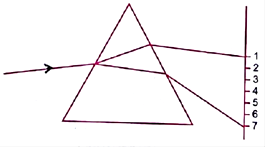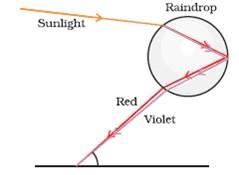A beam of white light falling on a glass prism gets split up into seven colours marked 1 to 7 as shown in the diagram.
A student makes the following statements about the spectrum observed on the screen.

i. The colours at positions marked 3 and 5 are similar to the colour of the sky and the core of a hard boiled egg respectively.
Is the above statement made by the student correct or incorrect? Justify.
ii. Which two positions correspond closely to the colour of
(a) a solution of potassium permanganate?
(b) ‘danger’ or stop signal lights?
OR
Describe the formation of rainbow in the sky with the help of a diagram.
i. The white light falling on a glass prism splits into 7 colour in the following sequence:
1. R – red
2. O – orange
3. Y – yellow
4. G – green
5. B – blue
6. I – indigo
7. V - violet
The position marked on number 3rd is YELLOW. Yellow is not the colour of the sky.
Similarly, the position marked on number 5th is BLUE. Blue is not the colour of the core of the hard-boiled egg.
Hence, the statement made by the student of no 3rd as the colour of sky and no. 5th as the colour of core of hard-boiled egg is INCORRECT.
ii. The colour of potassium permanganate is violet (purple), and the colour of danger sign is red.
a) The position corresponds closely to the colour of the solution of potassium permanganate is 7th (violet colour)
b) The position corresponds closely to the colour of danger or stops light signal is 1st (red colour).
‘OR’
FORMATION OF RAINBOW IN THE SKY:
1. A rainbow is a combination of 7 colours which is normally seen after rain.
2. A rainbow is formed naturally in the sky after rain shower opposite to the position of the sun.
3. Three different phenomena are involved in the formation of the rainbow: refraction, dispersion and reflection.
4. Refraction is a phenomenon in which the light turns or bends when it is passed from one medium to another having different optical densities.
5. Dispersion is the phenomenon of scattering of light into its seven components (colours).
6. Reflection is the phenomenon in which the light is sent or thrown back by a surface without absorbing it.
7. A rainbow appears by scattering of sunlight.
8. The water droplets act as tiny prisms which lead to scattering of light.
9. The prism refracts and scatters the sunlight.
10. This scattered light is then reflected by the water droplets.
11. When the light comes out of the water droplet, it is again bent due to refraction.
12. Due to this dispersion and reflection, different colours reach the observer’s eye making it a rainbow.
13. The formation of the rainbow is given in the diagram below:

Rainbow formation